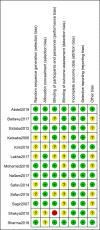5-HT3 receptor antagonists for the prevention of perioperative shivering undergoing spinal anaesthesia: a systematic review and meta-analysis of randomised controlled trials
- PMID: 33020100
- PMCID: PMC7537433
- DOI: 10.1136/bmjopen-2020-038293
5-HT3 receptor antagonists for the prevention of perioperative shivering undergoing spinal anaesthesia: a systematic review and meta-analysis of randomised controlled trials
Abstract
Objective: Perioperative shivering (POS) is a common complication in patients undergoing spinal anaesthesia. The present study investigated the efficacy of 5-HT3 receptor antagonists in preventing POS following spinal anaesthesia.
Design: Systematic review and meta-analysis.
Data sources: Pubmed, Embase, the Web of Science and Cochrane Library were searched from database establishment on 31 July 2019.
Eligibility criteria: Randomised controlled trials that reported the effects of 5-HT3 receptor antagonists in the prevention of POS in patients after spinal anaesthesia.
Data extraction and synthesis: Two reviewers independently extracted data. The primary outcome of the present study was the incidence of POS. The risk of bias for the included studies was assessed according to the Cochrane Handbook. The quality of primary outcome was evaluated by Grading of Recommendations Assessment, Development and Evaluation. Trial sequential analysis for the primary outcome was performed to reduce the type 1 error caused by repeated meta-analysis and the required information size was calculated.
Results: A total of 13 randomised controlled trials consisting of 1139 patients were included. The overall incidence of POS was significantly lower in the 5-HT3 receptor antagonists group (risk ratio 0.31; 95% CI 0.26 to 0.38; p<0.01; I2=0%). Subgroup analysis for different types of 5-HT3 receptor antagonists and timing of administration produced similar results. Also, patients had a lower incidence of postoperative nausea and vomiting after administrating 5-HT3 receptor antagonists. No statistically significant differences in drug-related adverse effects were observed. Grading of Recommendations Assessment, Development and Evaluation revealed a high level of evidence. The cumulative z-curve crossed the trial sequential monitoring boundary.
Conclusions: The present study revealed that prophylactic 5-HT3 receptor antagonists were an effective measure for reducing the incidence of POS in patients after spinal anaesthesia. However, further studies investigating the different types of surgeries are required.
Prospero registration number: CRD42019148191.
Keywords: 5-HT3 receptor antagonists; meta-analysis; perioperative shivering; spinal anesthesia.
© Author(s) (or their employer(s)) 2020. Re-use permitted under CC BY-NC. No commercial re-use. See rights and permissions. Published by BMJ.
Conflict of interest statement
Competing interests: None declared.
Figures








Similar articles
-
5-HT3 Receptor Antagonists for the Prevention of Perioperative Shivering: A Meta-Analysis.J Clin Pharmacol. 2017 Apr;57(4):428-439. doi: 10.1002/jcph.829. Epub 2016 Oct 13. J Clin Pharmacol. 2017. PMID: 27628928 Review.
-
5-HT3 receptor antagonists for the prevention of postoperative shivering: a meta-analysis.J Int Med Res. 2016 Dec;44(6):1174-1181. doi: 10.1177/0300060516668776. Epub 2016 Nov 18. J Int Med Res. 2016. PMID: 27856931 Free PMC article.
-
Effectiveness of Magnesium in Preventing Shivering in Surgical Patients: A Systematic Review and Meta-analysis.Anesth Analg. 2019 Sep;129(3):689-700. doi: 10.1213/ANE.0000000000004024. Anesth Analg. 2019. PMID: 31425208
-
Haloperidol Versus 5-HT3 Receptor Antagonists for Postoperative Vomiting and QTc Prolongation: A Noninferiority Meta-Analysis and Trial Sequential Analysis of Randomized Controlled Trials.J Clin Pharmacol. 2018 Feb;58(2):131-143. doi: 10.1002/jcph.999. Epub 2017 Sep 15. J Clin Pharmacol. 2018. PMID: 28914976 Review.
-
Droperidol and 5-HT3-receptor antagonists, alone or in combination, for prophylaxis of postoperative nausea and vomiting. A meta-analysis of randomised controlled trials.Acta Anaesthesiol Scand. 2000 Nov;44(10):1252-7. doi: 10.1034/j.1399-6576.2000.441011.x. Acta Anaesthesiol Scand. 2000. PMID: 11065206 Clinical Trial.
Cited by
-
Prevention of shivering post spinal anesthesia: Ondansetron vs. Nefopam ‒ a prospective randomized controlled trial.Braz J Anesthesiol. 2025 Jun 11;75(5):844650. doi: 10.1016/j.bjane.2025.844650. Online ahead of print. Braz J Anesthesiol. 2025. PMID: 40513826 Free PMC article.
-
A Randomized Controlled Trial for Prevention of Postspinal Anesthesia Shivering in Gynecological Surgeries: Mirtazapine vs. Dexamethasone.Anesthesiol Res Pract. 2022 Mar 9;2022:5061803. doi: 10.1155/2022/5061803. eCollection 2022. Anesthesiol Res Pract. 2022. PMID: 35310422 Free PMC article.
-
5-HT Receptors and Temperature Homeostasis.Biomolecules. 2021 Dec 20;11(12):1914. doi: 10.3390/biom11121914. Biomolecules. 2021. PMID: 34944557 Free PMC article. Review.
-
The effect of ketamine versus tramadol on prophylactic post-spinal shivering in those patients undergoing orthopedic surgery: a prospective cohort study design, 2020.BMC Anesthesiol. 2022 Nov 24;22(1):361. doi: 10.1186/s12871-022-01906-z. BMC Anesthesiol. 2022. PMID: 36424561 Free PMC article.
-
Comparison of intravenous butorphanol vs. tramadol for post-spinal anesthesia shivering: a meta-analysis and systematic review.Front Med (Lausanne). 2023 Dec 5;10:1271664. doi: 10.3389/fmed.2023.1271664. eCollection 2023. Front Med (Lausanne). 2023. PMID: 38116041 Free PMC article. Review.
References
Publication types
MeSH terms
Substances
LinkOut - more resources
Full Text Sources
Medical
